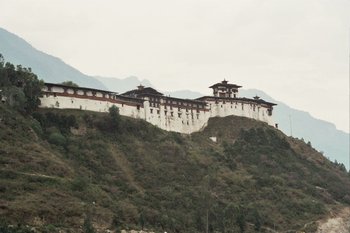Dzong architecture
|
|
Dzong architecture is a distinctive type of fortress architecture found in the former and present Buddhist kingdoms of the Himalayas, most notably Bhutan.
| Contents |
Characteristics of dzong architecture
The architecture is massive in style with towering exterior walls surrounding a complex of courtyards, temples, administrative offices, and monk housing. Distinctive features include
- high inward sloping walls of brick and stone painted white with few or no windows in the lower sections of the wall
- use of a surrounding red stripe near the top of the walls (perhaps punctuated by large gold circles)
- use of Chinese-style flared roofs atop interior temples
- massive entry doors made of wood and iron
- interior courtyards and temples brightly colored in Buddhist-themed art motifs
The campus architecture of the University of Texas El Paso (http://visitorcenter.utep.edu) is a rare example of dzong style seen outside the Himalayas.
Function
Dzongs serve as the religious, military, administrative, and social centers of their district. They are often the site of an annual tsechu or religious festival.
The rooms inside the dzong are typically allocated half to administrative function such as the office of the penlop or governor, and half to religious function, primarily the housing of monks. This division between administrative and religious functions reflects the idealized duality of power between the religious and administrative branches of government (see History of Bhutan).
Siting of dzongs
Bhutanese dzong architecture reached its zenith in the 1600s under the leadership of the great lama Shabdrung Ngawang Namgyal. The Shabdrung relied on visions and omens to site each of the dzongs. Modern military strategists would observe that the dzongs are well-sited with regard to their function as defensive fortresses. Wangdue Phodrang dzong, for instance, is set upon a spur overlooking the confluence of the Mo Chhu and Pho Chhu rivers thus blocking any attacks by southern invaders who attempted to use a river route to bypass the trackless slopes of the middle Himalayas in attacking central Bhutan. Drukgyel dzong at the head of Paro valley guards the traditional Tibetan invasion path over the passes of the high Himalayas.
Dzongs were frequently built on a hilltop or mountain spur. If the dzong is built on the side of a valley wall, a smaller dzong is typically built directly uphill from the main dzong with the purpose of keeping the slope clear of attackers who might otherwise shoot downward into the courtyard of the main dzong below.
Construction
By tradition dzongs are contructed without the use of architectural plans. Instead construction proceeds under the direction of a high lama who establishes each dimension by means of spiritual inspiration.
In previous times the dzongs were built using corvee labor which was applied as a tax against each household in the district. Under this obligation each family was to provision a decreed number of workers to work for several months at a time in the construction of the dzong.
Recent Scholarship
Recent research by the prominent Bhutanese scholar C.T. Dorji suggests that the original 'model dzong' may not be Simtokha dzong as commonly believed, but Dobji dzong, built in 1531 at an altitude of 6600 meters on a cliff facing the gorge of the Wangchhu River. Unlike the dzongs built under the direction of the Shabdrung for defensive purposes, Dobji dzong was constructed to serve a religious purpose, marking the spot where Ngawang Chogyel "...followed a spring water which originated from beneath the throne of Jetsun Milarepa in Druk Ralung to find a suitable site for establishing a center to propagate drukpa kagyu teachings in Bhutan".[1] (http://buddhistnews.tv/current/1st-zhong-030303.php)

